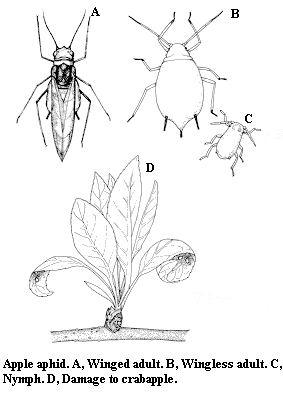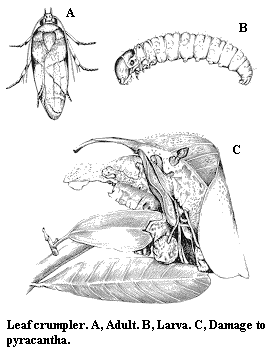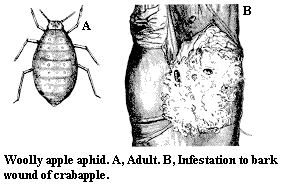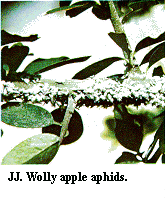Key to Pyracantha
Pyracantas have dark-green foliage, white clusters of springtime flowers, and fruit that matures into clusters of shiny yellow, orange, or red berries. They also have exceedingly sharp, strong thorns form which the get their name (pyr=fire, acatna=thorn). Southern nurserymen grow 200,000 pyracanthas each year. Although they are not fraught with pests, it is not unusual to find some of the insects below on most pyracanthas.
- Aphids – Small, soft bodied insects sucking sap from twigs of pyracanthas, especially in the spring.
- Apple aphid – Green to yellow-green or yellow with dark cornicles and legs.
- Woolly apple aphid – White, waxy filaments covering small, dark aphids.
- Hawthorne lace bug – Chlorotic spots on upper leaf surface, numerous dark spots of insect excrement on lower leaf surface; small, dark, spiny insects and slightly larger (3-mm), lacy insects with dark spots on wings.
- Leaf crumpler – Groups of leaves webbed together into a small, roughly globular shape; small, purplish, caterpillar inside webbing.
Apple Aphid
Apple aphid, Aphis pomi DeGeer, Aphididae, HEMIPTERA
DESCRIPTION
Adult – The apple aphid varies in size from 1.8 to 2.6 mm and in color from yellow to light green or dark green. The head, tips of the antennae, legs, and cornicles are dark. The stem mother is somewhat darker than other forms and is sometimes covered with a waxy bloom. The male is elongate, and the female is round. This aphid may be wingless or winged, or possess small wing remnants. Wings, if present, are transparent with brown veins and a smoky stigma.
Egg – The egg is oval, flattened on the side next to the bark. It is 0.6 mm long and 0.3 mm wide. Initially yellow (rarely green), the egg turns black.
Nymph - The first instar is dark green with dusky appendages. The nymph's color lightens as the nymph matures.
BIOLOGY
Distribution – The apple aphid is found throughout the United States and Europe.
Host Plants – Crabapple, hawthorn, mountain ash, and pyracantha are hosts for the apple aphid. The ornamental plants attacked by this insect are secondary hosts.
Damage – As they feed, apple aphids cause the foliage of terminal growth to curl. They also excrete honeydew (a nuisance) in which sooty molds sometimes grow. Heavily infested plants are often sticky with honeydew, dark with sooty molds, and disfigured by distorted new growth and cast aphid skins.
Life History – Overwintering as eggs on suckers and the terminals of trees, the aphids hatch in early spring and appear on the buds as the first leaves are unfolding. Throughout most of the year only females, which give birth to live young, are produced. The females that hatch from the overwintering eggs are called stem mothers. More than half of the offspring of the stem mothers are winged, and the first major dispersal occurs. This migration takes place in late May or early June. Winged individuals are produced throughout much of the summer but are most numerous in early summer.
Each female produces about 50 nymphs in a period of about 30 days. Stem mothers produce more offspring than succeeding generations. A female produces young aphids about 1 day after its final molt. The four nymphal instars develop within 2 weeks. As many as 16 generations can be produced in 1 year.
The apple aphid is most abundant from mid-June to the beginning of August. In early September, male and female aphids appear and mate. Mated females deposit one to six eggs, which develop partially before the first frost.
Populations of the apple aphid undergo fairly regular fluctuations in density throughout the summer. Because the aphid feeds only on new growth, the density of the populations is regulated somewhat by the growth of new shoots.
CONTROL
For specific chemical controls, see the current state extension recommendations.
Hawthorn Lace Bug
Hawthorn lace bug, Corythucha cydoniae (Fitch), Tingidae, HEMIPTERA
DESCRIPTION
Adult – About 3.4 mm long and 1.8 mm wide, the small adult has lacy wings with large, brown areas. The antennae and legs are yellowish (Figure V).
Egg – The egg is sharply truncate, having the appearance of a small cone. It is smooth, whitish, and semitransparent with a white cap; however, the female often secretes a brownish substance that hardens over the eggs, obscuring their characteristics.
Nymph – There are five nymphal stages distinguished by the varying spines that occur over their bodies. The nymphs are dirty brown, and the later stages become broadly oval and flat.
BIOLOGY
Distribution – Native to the United States, the hawthorn lace bug was first recognized as a serious pest in the middle 1800's. The hawthorn lace bug occurs throughout the United States and in parts of Canada and Mexico.
Host Plants – The hawthorn lace bug feeds on a number of plants in the rose family. It has been reported on apple, button bush, cotoneaster, hawthorn, juneberry (or serviceberry), loquat, oak, pear, pyracantha, and quince.
Damage – Both the nymphs and adults suck fluids out of the leaves from the undersurfaces, speckling the tops of the leaves with yellowish spots. The lower surfaces of the leaves also become discolored with cast skins and excrement (Figure V). Extensive feeding can cause wilting of the leaves.
Life History – This lace bug is known to overwinter in the adult stage. However, it may overwinter in the egg stage when developing on evergreen hosts. A New England study indicates that development from egg to adult takes about 7 weeks, though the length of time seems to depend upon the temperature. About 40 eggs are laid per leaf in groups of 10 to 30 along the sides or prominent veins on the undersurface. There are five nymphal stages, with only one full generation per year occurring in the New England area. Adults are first noticeable in early May and are found in New England as late as November. They overwinter under leaves, stones, bark, and other natural cover.
CONTROL
Treatment should begin as soon as the lace bugs or their damage is seen. Properly labeled chemicals should be used and safety precautions listed on the labels should be followed. For specific chemical controls, see the current state extension recommendations.
Leaf Crumpler
Leaf crumpler, Acrobasis indigenella (Zeller), Pyralidae, LEPIDOPTERA
DESCRIPTION
Adult – The leaf crumpler moth has a wingspan of 15 to 20 mm. The forewings are light brown with a white patch on each wing and several black lines. The hind wings are lighter in color than the forewings.
Egg – The egg of this insect has not been described.
Larva – The larva of the leaf crumpler varies in size (14.5 to 17.5 mm long). Its head is pale reddish brown; the top of the body is grayish green with some purplish markings, particularly where the segments overlap; the underside is pale grayish green.
Pupa – Measuring about 7 to 9 mm long, the pupa is yellowish brown to reddish brown and slightly darker dorsally.
BIOLOGY
Distribution – Although it is generally found east of the Rockies, the leaf crumpler also occurs in California.
Host Plants – Apple, cherry, cotoneaster, crabapple, hawthorn, peach, pear, plum, prune, pyracantha, and quince have been recorded as hosts of the leaf crumpler.
Damage – Damage is caused by the feeding of the larvae and the tubes and clusters of leaves they form. Girdling of the twigs and feeding on the buds and fruit (probably caused by crowding) have also been reported.
Life History – In the southeastern United States there are two generations of leaf crumplers each year. Eggs are deposited on the foliage, and they hatch in 2 to 3 weeks. The larvae construct tubes that are attached to twigs of host plants. As the larvae mature, they expand their tubes with silk and leaf fragments. The sinuous tubes can be 5 to 6 mm wide and 30 to 40 mm long when the larvae are fully grown. In late July and mid-August, larvae seal over the ends of the tubes and pupate. Pupation lasts about 2 weeks. Leaf crumplers overwinter as partially grown larvae in the tubes on the host. In the spring in eastern North Carolina, the larvae become active and resume their feeding. These larvae pupate about the middle of May.
During the winter, the first 5 to 10 mm of the reddish-brown tube may become detached from the host. The larvae seal up the open end so that the end of the tube is flat. Larvae first feed on developing leaves near their tubes; but when the adjacent food supply is depleted, they leave their shelters in search of more plant material. These wanderings are usually at night. Leaves brought back to the tube frequently dry and become unpalatable. The accumulation of dry leaves offers additional protection and may result when two or more larvae feed in proximity to one another.
CONTROL
For specific chemical controls, see the current state extension recommendations.
Woolly Apple Aphid
Woolly apple aphid, Eriosoma lanigerum (Hausmann), Aphididae, HEMIPTERA
DESCRIPTION
Adult – Several different forms of the adult woolly apple aphid exist. The globose, 2-mm-long stem mothers are yellowish or reddish with dark dorsal markings and are covered with bluish-white, waxy material that is longer caudally (Figure JJ). Other wingless females are rusty or reddish brown, occasionally slightly purple. These females are smaller and more elongate than the stem mothers. Winged females are reddish brown and do not possess as much wax as the wingless forms. The sexual forms, which are the smallest, are covered by a fine, powdery wax and lack mouthparts. The legs and heads of all the adult forms are darker than their bodies.
Egg – The dark, glistening egg is oval and about 0.3 mm long.
Nymph – The nymph is similar to the wingless adult but is smaller and does not have as much waxy material.
BIOLOGY
Distribution – The woolly apple aphid is found throughout the United States.
Host Plants – Elm is the primary host; but apple, hawthorn, mountain ash, pear, and quince are secondary hosts
Damage – Stem mothers feed at the base of leaf buds, causing the leaves to curl and thicken once the leaves begin to develop. This damage forms a rosette of deformed leaves. Woolly apple aphids are particularly drawn to open wounds or pruning scars. If the insects are feeding on branches or twigs, galls or knotty swellings are produced at the feeding sites. These galls may be 13 to 75 mm long depending on the severity of the infestation. Eventually, the bark splits as the tree attempts to cover the galls with new growth. Similar swellings are formed on the roots after the insects feed there.
Life History – Elm is the primary host of the woolly apple aphid. Apple is a secondary host, although the aphids are capable of living for several years on the roots of apple trees without migrating back to elm. Overwintering occurs on both hosts. On elm, the overwintering stage is the egg, which is deposited in crevices in the bark. On apple, the young nymph attached to the roots is the overwintering form.
In the spring, the eggs on elm hatch into wingless females called stem mothers. These aphids and succeeding generations give birth to live young without mating. The stem mothers' offspring are winged, and they migrate to apple. A single stem mother was recorded as producing 299 nymphs; however, the average number of offspring is much lower and varies according to the form of aphid. Wingless forms average about 30 young per female; winged forms, about 6; and those feeding on apple roots, about 85. The four nymphal instars develop in 8 to 20 days. Adults live about 25 days. As many as 18 generations can be produced in 1 year. Sometimes the next to the last generation on apple is winged and migrates to elm, where male and female aphids are produced. These aphids mate, and the female deposits one egg.
CONTROL
For specific chemical controls, see the current state extension recommendations.
Publication date: Jan. 1, 1993
Reviewed/Revised: Aug. 9, 2024
AG-189
Other Publications in Insect and Related Pests of Shrubs
N.C. Cooperative Extension prohibits discrimination and harassment regardless of age, color, disability, family and marital status, gender identity, national origin, political beliefs, race, religion, sex (including pregnancy), sexual orientation and veteran status.






